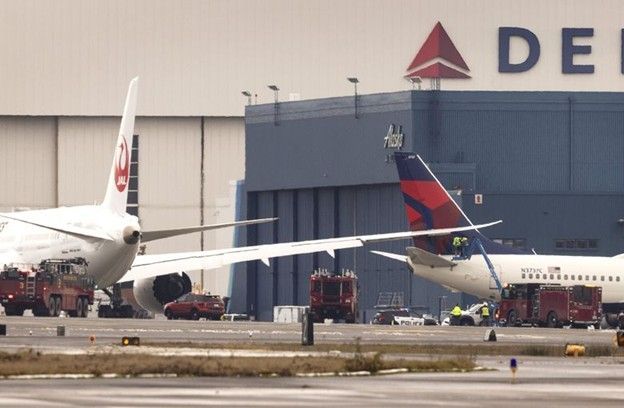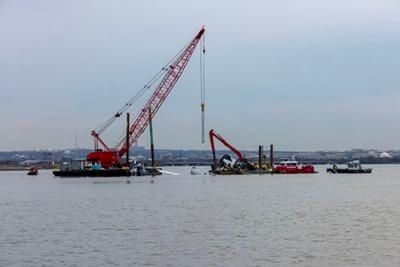ARFF Daily News
Published on:
Thursday the 6th of February, 2025
Japan Airlines plane strikes parked Delta plane at Sea-Tac Airport
By Lauren Rosenblatt and Paige Cornwell
After a taxiing plane struck a parked aircraft at Seattle-Tacoma International Airport on Wednesday, passengers and regulators scrambled to understand what had happened — but with no injuries or major disruptions to air travel, the airport remained mostly calm amid a puzzling sequence of events.
The incident happened around 10:15 a.m. Wednesday after Japan Airlines Flight 68 landed from Tokyo at Sea-Tac and began taxiing toward the S Concourse.
Nearby, Delta Air Lines Flight 1921 was parked as it waited for deicing before taking off for Puerto Vallarta, Mexico. The plane had 142 passengers on board, according to the airline.
As the Japan Airlines plane was taxiing, the right wing of the aircraft, a Boeing 787 Dreamliner, struck the tail of the Delta jet, a Boeing 737 Next Generation. The Japan Airlines plane had 172 passengers and 13 crew members on board after the nine-hour flight.
The damage to both planes was significant, according to Port of Seattle spokesperson Perry Cooper. The Federal Aviation Administration temporarily slowed down air traffic at Sea-Tac but it did not cause any major disruptions, Cooper said.
Both aircraft had been removed by Wednesday afternoon.
Now, the FAA will investigate what went wrong and may tap the National Transportation Safety Board, Cooper said. The FAA said the aircraft were in an area that is not under air traffic control.
Japan Airlines said in a statement Wednesday afternoon “We sincerely apologize to all involved for any inconvenience. The detailed cause and circumstances are currently under investigation.”
Brett Powers, 67, from La Conner, Skagit County, was a passenger on the Japan Airlines plane. He said the flight had landed on time and was heading toward the S Concourse when the pilot told passengers the gate they were slotted to taxi to was full.
The pilot estimated they’d wait about 10 minutes before making another attempt to enter, Powers said. Instead, the plane started taxiing a few minutes later.
Then Powers heard someone start to scream.
He couldn’t make out what the passenger on the other aisle of the plane was yelling and assumed the passenger was having a medical emergency, he said.
Moments later, Powers felt a jolt. “It felt like the pilot had hit the brakes really hard,” Powers said.
Other than the initial yelling, Powers said passengers on board did not panic and nobody appeared to be hurt. The cabin crew remained calm.
Powers had been flying back to Seattle after a three-and-a-half-week trip visiting China, Vietnam, Thailand and other countries. He travels often, he said, and the bump Wednesday didn’t make him more fearful of air travel.
Still, “that was a new one for me,” Powers said after deplaning.
It’s too soon to know what caused the planes to hit but Cooper, from the Port of Seattle, said Wednesday afternoon he didn’t expect the day’s snowy conditions led to the incident. The space was bare and wet at the time of the hit, he said.
It’s not unusual for aircraft to taxi after landing and before deplaning, Cooper said, particularly at Sea-Tac.
“We have one of the smallest footprints in any airport in the country, with the amount of operations we have here,” he said.
He estimated the taxiing Japan Airlines plane was traveling 10-20 mph before it hit the Delta jet.
Delta rebooked passengers on another flight to Puerto Vallarta on Wednesday afternoon, Cooper said. Japan Airlines canceled its next scheduled flight to Tokyo later that day, leaving many passengers rushing to figure out new travel plans.
Japan Airlines originally told passengers the flight was delayed, three passengers said. It took over an hour for them to learn the flight had been canceled and those passengers said they first found out by looking it up online, rather than through communication from the airline.
Two passengers said they could see the chaos below them from the lounge but that the airline had not told them what went wrong.
Later that morning, their mobile tickets showed the flight had been canceled due to an aircraft rotation, according to two tickets shared with The Seattle Times.
Amy Fustino, 42, from Bremerton, was traveling to Japan for work and was frustrated Wednesday about the unexpected change of plans. She was able to rebook a flight for the next day but is now flying a different airline and to a different airport. That means she has to recoordinate travel when she lands and her team is “going to have to pick up the slack” without her there.
She was frustrated the airline didn’t communicate that the flight had been canceled earlier. “I would have had more control about still being able to get out today,” Fustino said.
But she wasn’t rattled by the events on the tarmac. “I just feel like it’s par for the course at this point,” Fustino said.
She’s not worried about her flight Thursday because “I’m going to change airlines.”
Josh Blaine, Troy Lian and Colin Hooper, all from the Seattle area, were traveling to Japan with a group of 10 friends from high school for vacation.
When the flight was canceled, Japan Airlines told them it couldn’t help rebook unless they chose to do so through the airline’s website. Because the group had used different platforms to book, they scattered around the airport to talk with agents as they tried to secure refunds and new bookings.
The three friends found out the flight had been canceled while they were waiting at the gate but said they couldn’t see or hear any indication that something went wrong.
“I’m surprised nobody noticed,” Hooper said.
The scene at the gate remained calm, even as all the passengers found out what had happened, the friends said. Instead of panic over the two jets hitting, there was panic over rebooking.
Seema Khincha and her 11-year-old son Anshul got to the airport early for their flight Wednesday because they were worried the snowy weather may cause delays.
Khincha, from Kirkland, was flying on Japan Airlines to Tokyo and then on to Bengaluru, India, also known as Bangalore, to celebrate her father’s 79th birthday. Now she doesn’t know if she’ll make it.
“It scares me. I don’t know if I’ll travel again in the near future,” she said, referring to the incident Wednesday at Sea-Tac and recent crashes, including in South Korea and Washington, D.C.
Asked if she plans to rebook her flight, Khincha said, “It’s too much to process. All I’m doing is waiting for my luggage and going back home.”

4 reported dead in Maguindanao plane crash
POLITIKO.COM.PH
Four persons were reported dead after a small plane crashed in Ampatuan, Maguindanao del Sur on Thursday afternoon.
Former Ampatuan Vice Mayor Rasul Sangki in a media interview said at least four bodies were recovered at the crash site in Barangay Malatimon.
“Nakita natin, apat po ang namatay. Parang wala atang naka-survived sa nangyari. Hindi pa natin alam kung ano ang nangyari,” Sangki said.
Residents in the area said they heard a loud crashing sound when the plane plunged into a rice field, past 2:00 p.m.
Initial information revealed that the plane with body number N349CA came from Mactan in Cebu and was in route to Cotabato when the accident happened.
https://mindanao.politiko.com.ph/4-reported-dead-in-maguindanao-plane-crash/

NTSB Update On DC Mid-Air Collision
Navy Salvage Team, FBI Divers Recovering CRJ Wreckage
The NTSB has been working in coordination with the U.S. Navy Supervisor of Salvage and announced that some parts of the CRJ700 passenger were recovered on February 4, 2025, including the aft section of the fuselage, the right engine, and right pylon. Salvage operations are continuing and FBI divers will be recovering smaller sections of the wreckage.
Recovery operations are currently concentrating on the Bombardier CRJ700 and will then turn to the Sikorsky UH-60 Black Hawk military helicopter. Completion of recovery operations are anticipated to take several more days.
The NTSB investigators said they have obtained training and flight logs for both crews as well as the maintenance logs for both aircraft. The agency’s human performance team is putting together histories for both crews extending back several days and will include their daily activities. The air traffic control group has conducted interviews with all five staff members in the tower.
The NTSB team is also working on synchronizing data from the flight data recorders and cockpit voice recorders from both aircraft with ATC communications and radar scope data to construct a detailed timeline of events preceding the collision.
The accident involved a PSA Airlines Bombardier CRJ700 operating as American Airlines Flight 5342 from Wichita, Kansas, on final approach to Reagan Washington National Airport and a U.S. Army Sikorsky UH-60 Blackhawk helicopter. The aircraft collided in the air over the Potomac River near the passenger jet’s destination.
The NTSB arrived and documented the wreckage, collected evidence, and interviewed witnesses. While the investigation is still ongoing, the agency expects to release a preliminary report by the end of February containing only the factual information gathered during this phase of the investigation. The release of its full report with probable cause and contributing factors is anticipated in 12 to 24 months.
FMI: www.ntsb.gov/


NTSB Prelim: Zenith 601XL
Pilot Had Just Completed The Airplane Build And Was Operating The Airplane As A Test Flight
Location: Albertville, AL Accident Number: ERA23FA254
Date & Time: June 3, 2023, 13:20 Local Registration: N601YP
Aircraft: Zenith 601XL Injuries: 1 Fatal
Flight Conducted Under: Part 91: General aviation - Flight test
On June 3, 2023, at 1320 central daylight time, an experimental, amateur-built Zenith 601XL, N601YP, was substantially damaged when it was involved in an accident near Albertville, Alabama. The commercial pilot was fatally injured. The airplane was operated as a Title 14 Code of Federal Regulations Part 91 flight.
Preliminary Automatic Dependent Surveillance - Broadcast (ADS-B) data revealed that the flight departed Albertville Regional Airport-Thomas J Brumlik Field (8A0), Albertville, Alabama at 1220. The airplane departed the airport traffic pattern to the southwest and flew for about 1 hour, performing several heading changes, and a climb to 4,000 ft mean sea level (msl) before descending to 2,000 ft msl, then leveling-off shortly before contact was lost. According to witnesses, the pilot had just completed the airplane build and was operating the airplane as a test flight.
Several witnesses near the accident site reported that the airplane appeared to “porpoise” several times. The engine then increased to full power and the airplane nosed over into a vertical descent before disappearing behind a tree line.
The airplane impacted trees and terrain and came to rest inverted on the side of a stream bed about 2 miles northwest of 8A0 at an elevation of 1,007 ft. All major components of the airplane were located at the accident site. The wreckage path was oriented on a heading of 057° magnetic and was about 40 ft long. The fuselage, empennage, wings, and all flight controls were discovered in the immediate vicinity of the primary impact site. The engine was separated and located about 25 ft forward.
Shattered tree branches, several of which exhibited features consistent with propeller slice marks were located around the impact site. Both wings were displaced aft but remained attached to the wing spar; the two internal fuel tanks were severed from their internal mounts and were located in the debris field; the fuel tanks were compromised and there was the smell of automotive gasoline in the area along with vegetative blight on the grass and surrounding leaves and bushes.
Examination of the airframe revealed that the elevator trim and its respective servo were in the full-up position (nose down trim). The flaps were retracted (up), the vertical stabilizer which also operates as a rudder fractured from its connection points but remained in the vicinity of the main wreckage. All other flight controls remained partially attached to their respective mounts. Control continuity was established by tracing the control cables to their respective positions and manually noting corresponding movement of the control surface.
Examination of the engine revealed that the propeller hub remained attach to the flange. Two propeller blades were fractured and severed about 3 inches outward from the hub and one blade was fractured about 9 inches outward from the hub. Several pieces of delaminated propeller blades were distributed throughout the accident site in multiple directions along the wreckage path. Engine crankshaft continuity was confirmed and there was smooth action of all rockers, valves, and springs when the crankshaft was rotated 720°. Compression and suction were attained on all cylinders and the spark plugs exhibited normal wear. A cockpit multi-function display was recovered from the accident site and sent to the NTSB Recorders Laboratory, Washington, DC, for data download.
The wreckage was retained for further examination.
FMI: www.ntsb.gov

Today in History
29 Years ago today: On 6 February 1996 Birgenair flight 301, a Boeing 757, crashed into the sea off Puerto Plata, Dominican Republic, following a loss of control, killing all 189 occupants.
Date: Tuesday 6 February 1996
Time: 23:47
Type: Boeing 757-225
Owner/operator: Alas Nacionales, lsf Birgenair
Registration: TC-GEN
MSN: 22206/31
Year of manufacture: 1984
Total airframe hrs: 29269 hours
Cycles: 13499 flights
Engine model: Rolls-Royce RB211-535E4
Fatalities: Fatalities: 189 / Occupants: 189
Other fatalities: 0
Aircraft damage: Destroyed, written off
Category: Accident
Location: 26 km NE off Puerto Plata, Dominican Republic - Atlantic Ocean
Phase: En route
Nature: Passenger - Non-Scheduled/charter/Air Taxi
Departure airport: Puerto Plata-La Union International Airport (POP/MDPP)
Destination airport: Gander Airport, NL (YQX/CYQX)
Investigating agency: DGAC Dom. Rep.
Confidence Rating: Accident investigation report completed and information captured
Narrative:
Birgenair flight 301, a Boeing 757, crashed into the sea off Puerto Plata, Dominican Republic, following a loss of control, killing all 189 occupants.
Alas Nacionales flight 301 departed Puerto Plata for a charter flight to Frankfurt via Gander and Berlin at 23:42 LT. At 80 knots on takeoff the captain found out that his air speed indicator (ASI) wasn't working properly. The co-pilot's indicator seemed to work fine. While climbing through 4700 feet the captain's ASI read 350 knots (real speed was about 220 kts); this resulted in an autopilot/autothrottle reaction to increase the pitch-up attitude and a power reduction in order to lower the airspeed. At that time the crew got 'Rudder ratio' and 'Mach airspeed' advisory warnings. Both pilots got confused when the co-pilot stated that his ASI read 200 knots decreasing while getting an excessive speed-warning, followed by a stick shaker warning. This led the pilots to believe that both ASIs were unreliable.
Finally realizing that they were losing speed and altitude they disconnected the autopilot. The autopilot, fed by the captain's faulty ASI, had reduced the speed close to the stall speed. Full thrust was then applied. At 23:47:17 an aural GPWS warning sounded. Eight seconds later the aircraft struck the ocean.
The incorrect ASI readings were probably caused by the obstruction of the pitot system by mud and/or debris from a small insect that was introduced in the pitot tube during the time the aircraft was on the ground. The aircraft was not flown for 20 days before the crash and was returned for service without a verification of the pitot-static system as recommended by Boeing.
PROBABLE CAUSE: "The crew's failure to recognize the activation of the stick shaker as a warning of imminent entrance to the stall, and the failure of the crew to execute the procedures for recovery from the onset of loss of control."

Mailing Address
Subscribe to our newsletter
Contact Us
We will get back to you as soon as possible.
Please try again later.
